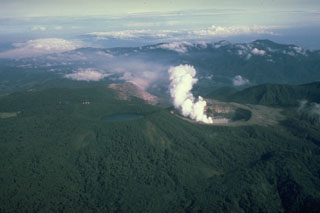Report on Poas (Costa Rica) — 19 March-25 March 2025
Smithsonian Institution / US Geological Survey
Weekly Volcanic Activity Report, 19 March-25 March 2025
Managing Editor: Sally Sennert.
Please cite this report as:
Global Volcanism Program, 2025. Report on Poas (Costa Rica) (Sennert, S, ed.). Weekly Volcanic Activity Report, 19 March-25 March 2025. Smithsonian Institution and US Geological Survey.
Poas
Costa Rica
10.2°N, 84.233°W; summit elev. 2697 m
All times are local (unless otherwise noted)
The Observatorio Vulcanológico y Sismológico de Costa Rica-Universidad Nacional (OVSICORI-UNA) reported that eruptive activity at Poás continued at an elevated level during 19-25 March. Significant inflation continued to be detected and gas-and-steam emissions were ongoing. Analysis of the ash revealed a significant amount, around 20 percent, of juvenile material. Sulfur dioxide emissions fluctuated at high levels, with averages ranging from 675-844 tons per day (t/d) during 19-20 March, based on MultiGAS station data. Sulfur dioxide emissions detected in satellite data were as high as 844 t/d on 20 March. Occasional phreatic eruptions were recorded by the seismic and acoustic network. Two small phreatic eruptions on 19 March ejected material 50-100 m high and another recorded at 1815 on 20 March produced a 200-m-high plume. A small phreatic eruption at Boca C on 23 March was followed by a period of small, very frequent events during 23-25 March; weather conditions obscured views of the crater. Video from 0747 on 25 March showed a phreatic eruption ejecting dark material above the vent and a steam plume drifting downwind. Ballistics were ejected onto the crater floor. The Alert Level remained at 3 (the second highest level on a four-level scale) and the Aviation Color Code remained at Orange (the second highest color on a four-color scale).
Geological Summary. The broad vegetated edifice of Poás, one of the most active volcanoes of Costa Rica, contains three craters along a N-S line. The frequently visited multi-hued summit crater lakes of the basaltic-to-dacitic volcano are easily accessible by vehicle from the nearby capital city of San José. A N-S-trending fissure cutting the complex stratovolcano extends to the lower N flank, where it has produced the Congo stratovolcano and several lake-filled maars. The southernmost of the two summit crater lakes, Botos, last erupted about 7,500 years ago. The more prominent geothermally heated northern lake, Laguna Caliente, is one of the world's most acidic natural lakes, with a pH of near zero. It has been the site of frequent phreatic and phreatomagmatic eruptions since an eruption was reported in 1828. Eruptions often include geyser-like ejections of crater-lake water.
Source: Observatorio Vulcanologico y Sismologico de Costa Rica-Universidad Nacional (OVSICORI-UNA)

